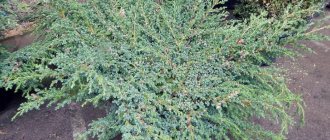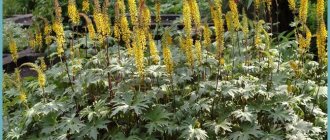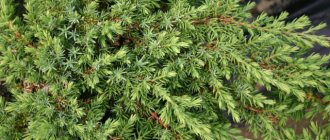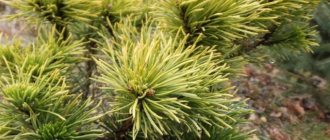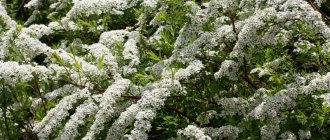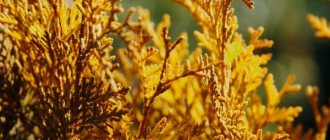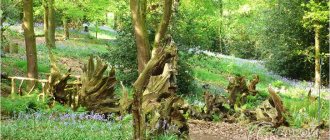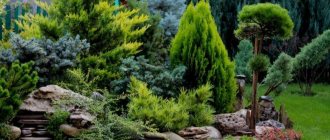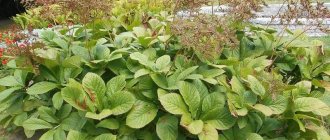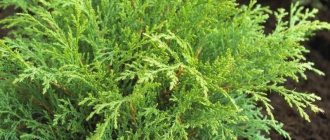In recent years, landscape design has become more and more interesting and original. The most popular form of wood is a standard, but not everyone knows what it is.
Such plants have a smooth, straight trunk without unnecessary branches, and the foliage droops or forms a spherical crown.
During flowering, trees and shrubs look like huge open buds.
Plant species
The height of a standard tree usually does not exceed two meters. But some specimens grow up to 5 m. Properly decorated plants look attractive at any time of the year. Even in winter, when all the leaves fall, the crown retains its spherical shape. It becomes covered with snow, turning the tree into a huge snowflake. And in the summer the first flowers and fruits appear.
In addition to beauty, such plants have other advantages. Standard trees are quite compact; they will not take up much space on the site. A round crown is easier to process and harvesting from it is much simpler.
The most common form of trunk is weeping. Usually they try to stylize rowan, elm, goat willow, and some varieties of apple trees.
Such plants were transplanted to the site from the wild or bred artificially.
If you graft a tree at the bottom of the rootstock, the branches will be creeping.
And when working with a tall trunk, you will get a penetrating crown; it comes in four types:
- reflex;
- inverse;
- pendula;
- umbrella.
With a reflex, the shoots grow vertically downward, and with inversion, in an arc. A pendula is a crown shape in which the branches hang at an angle of 60 or 30 degrees. In umbrella trees, the shoots are directed horizontally and rise slightly.
If you form a trunk on shrubs such as cotoneaster or juniper, their crown will be weeping. And thuja, acacia, larch and maple will take the shape of a ball.
Such trees are usually planted along alleys or near buildings to maintain asymmetry. They look good with pyramid-shaped shrubs.
Bright originality
With the help of juniper bushes you can make a wide variety of shapes in your garden.
Japanese larch is very popular. The fall of leaves characteristic of coniferous needles does not reduce its popularity. Smooth horizontal branches and a multi-peaked larch trunk make it possible to easily shape it into a ball. Despite the mandatory condition of maintaining a distance of 3-4 m from the larch trunk, the opportunity to decorate the site with bright colors with other trunks is not missed by any professional designer.
Weeping pendula larches are widely used in decoration. These include conifers, broom, elm and other deciduous trees. One of the main representatives of pendula can be called broom.
Pendula broom, or, as it is popularly called, goat willow, is incredibly beautiful. Delicate branches flow downwards, using this property, you can give an interesting shape to the trunk. Rakita pendula will help decorate any chaotic pile of rocks near a small pond. The standard form of the weeping pendula has rapid growth and in a short time reaches 3 m. The dense crown makes it possible to show imagination and make the landscape of any dacha or country house mysterious. This plant variety is frost-resistant and does not require special preservation conditions in winter, but in warm times the strict requirement of abundant watering should in no case be neglected.
Trimming branches
The easiest way to make a standard is by cutting shoots. Beginning gardeners can also cope with this technology. It is necessary to trim the side shoots, giving the tree a ball shape. But this will take many months, although the result will exceed all expectations.
It’s easy to decorate a tree with your own hands. It is enough to follow some rules:
- choose the right seedling;
- tie up a plant;
- use support;
- pin the top.
It is important to choose a suitable seedling. It should have a smooth, even trunk. Only from this can a standard tree be grown. Immediately after planting, the tree is tied to a metal peg. This will ensure proper growth. As the seedling grows, it is constantly tied to a support to keep it level. Once the tree reaches the desired height, you need to pinch its top.
After this procedure, side shoots will begin to actively grow. This usually takes no more than one year. The young plant also needs to be pinched regularly, then you can form a round crown with your own hands.
How to make a plant on a trunk
Typically, nurseries are engaged in growing standard trees and shrubs. However, if you have the time and desire, you can try to do it yourself. There are two ways to create plants on a trunk.
Trimming
If you are planning to make a standard plant by pruning, select the straightest and strongest seedling. To prevent the wind from breaking it, tie it to a peg driven into the ground. As it grows, the peg will have to be replaced with a longer one so that it always remains the same height as the stem.
Grafting method
You can get beautiful trees by grafting. But this option requires much more effort and time. You need to purchase two seedlings - a rootstock and a scion. The first will be used as a standard, and the crown will be formed from the second.
Although both trees should be from the same crop, it is better to choose one stronger than the other. A rose can be grafted onto a rosehip, but a rough elm is suitable for a weeping elm.
But sometimes seedlings of different crops are used. This is a more difficult method, since it is not always effective.
The standard can be decorative, and the scion can be fruitful. In this case, fruits will appear on the tree a little earlier - already in the third year after planting.
During vaccination, you also need to follow some rules:
- first you need to grow a standard;
- then the tree is grafted;
- an oblique cut is made above the upper bud of the scion;
- the resulting wedge is inserted into the standard;
- after a month, new shoots are pinched.
First, they plant a tree, tie it up and wait until it grows to a certain height. Next April you need to prepare a cutting with 3-4 live buds. An oblique cut is made above the top, and a wedge is made in the lower part with two cuts. It is inserted into a sprouted standard. This is done very carefully so as not to damage the seedlings.
The junction must be rewound with polyethylene tape and treated with garden varnish. Otherwise, the standard and scion may rot.
In about a month, the cutting will take root and produce its first buds. Next, young shoots will appear from them. They need to be carefully looked after, since it is these branches that will form the crown. Shoots must be pinched periodically. After two seasons, the tree will be fully formed and beautiful. You can plant more than one standard tree at once. There is no doubt that such a solution will radically transform landscape design.
With careful care of the plants, in a few years the garden will be completely transformed.
Mixborders and multi-level compositions
Translated from English, the phrase “mixed border” is translated as mixed border. In landscape design, this is the name given to complex flower beds and flower beds that remain decorative from early spring until late autumn. Presentable appearance, which remains with the plant throughout the entire season, is an important criterion, which, however, not all plants fit.
A rich palette of colors and a large selection of shapes allow junipers to be used in compositions with a wide variety of ornamental crops. And not necessarily as a background for beautifully flowering ones. A large selection of colors and shapes makes possible combinations based on coniferous trees and shrubs with crowns of different shapes and decorative foliage annuals and perennials.
Formation of shrubs
The trunk can be formed not only on trees, but also on shrubs. You can work with currants, irga, gooseberries and other fruit-bearing or ornamental plants. After this procedure, the crops are much easier to care for and much easier to pick berries.
You can get standard shrubs in two ways: trim the side shoots or graft other seedlings. It is better to choose the latter method. In early spring, sap begins to actively move through the branches of the bush. Select suitable cuttings for the trunk and scion (golden currant is suitable for any plant).
Everything needs to be done the same way as with trees . On the cuttings with buds, cuts are made at the bottom and top, and they are inserted with a wedge into the germinated trunk. The junction is wrapped in polyethylene, and when the first shoots appear, it must be removed. When the film is removed, the bush must be treated with special solutions (insecticides or fungicides) to prevent parasites from appearing on it.
Currants and gooseberries cannot grow without strong support. Shrubs are fragile, so they can break under the influence of strong winds. Metal or wooden rods can be used as support. Next season the first berries will appear, but they will be different from those before. The new fruits are larger and sweeter in taste.
Benefits and uses in landscape design
Decorative conifers are used by designers in styles that are characterized by strict geometric shapes combined with naturalness.
- The English or regular style is characterized by a perfectly flat lawn and large shapes. Large varieties of juniper are planted singly or in small groups. Pruning is actively used to give the plant shape.
- Japanese style involves a combination of conifers and stones, both natural and artificial. Japanese gardeners give preference to low-growing forms with an irregular crown shape.
Juniper will find a place in any garden; it can be planted:
- as a hedge or border;
- as a cover plant;
- plant in rock gardens and rockeries;
- with the help of juniper they strengthen crumbling slopes;
- Ephedra goes well with other plants.
Evergreen juniper is suitable for decorating the front area. Dwarf forms are suitable for the home garden.
Conifers are durable and unpretentious, which is a definite plus for site owners. Most types of juniper do not require pruning.
Important Tips
It is difficult for novice gardeners to understand the stamping procedure, which means they can make serious mistakes. They will benefit from recommendations from more experienced owners:
- it is necessary to germinate the trunk;
- scion cuttings are selected in April;
- it is necessary to make the cuts correctly;
- It is advisable to use garden varnish.
After planting, the trunk is tied up and germinated immediately to the desired height. If this is a tree, then it should be one and a half meters or taller; for shrubs, 50-70 cm is enough. All this time it is attached to a support. In April, young cuttings are selected for scion. They must have buds on them. For a wedge, two cuts are made at the bottom, and for proper germination, one at the top of the shoot.
You need to insert the cutting into the stem so as not to damage both plants. You should not use sharp or metal objects; it is better to do everything with your hands. The attachment point is sealed with polyethylene and lubricated with garden varnish to avoid the penetration of pests and rotting.
If an ornamental plant was chosen for the trunk , then it is better to place it on the lawn. When the flowers appear, they will look beautiful against the green grass. But the space around the trunk is cleared of lawn and mulched. To do this, prepare a mixture of peat, sand, pebbles and sawdust. It is sprinkled on the ground and covered with paper or film.
The thickness of the embankment should reach 12 cm. This layer helps the soil warm up faster in summer and protects it from freezing in winter.
Mulch retains moisture, allowing the plant to constantly feed, and it also prevents weeds from growing.
Planting and caring for coniferous trunks
Trimming the trunks is done with special garden shears.
Having examined the varieties of standard plants, we will become familiar with the method of planting coniferous standard trees. When purchasing a plant from a nursery, it is considered mandatory to remember the location of the cardinal directions. It is worth tying a ribbon on a branch on the south side of the tree so that when planting it in the ground on your site, you can maintain this position. By observing this condition, you can speed up the plant’s adaptation to a new location.
The planting depth should correspond to the height of the formed root system with a margin of 15-20 cm. The margin is made to create a bottom cushion consisting of mixed pine sawdust and river sand in a ratio of 2:1. This pillow can also be used to cover the side edges of the roots. Black soil is sprinkled on top for compaction and nutrition. Careful attention to watering (as the soil dries, the soil should be moistened, but not flooded) will help any coniferous trunk quickly take root. Do not forget to cover the crown of the conifer for the winter, so as not to expose the delicate needles and cut edges of the branches to the sun.
Rules of care
Standard trees need to be carefully looked after. First of all, you need to monitor the condition of the bark. Pests and parasites will enter the tree through the slightest cracks. Because of them, the trunk is covered with lichens and moss.
In autumn, dead areas are removed using a brush with thick metal bristles. Healthy bark should not be touched; damage to it will also lead to the development of diseases in the plant. Only mature trees can be whitewashed; their trunks have already developed sufficiently and become strong. If the boles have a smooth surface, then it is better not to cover them with lime mortars.
Periodically remove dried and damaged foliage. This will help maintain the correct shape of the crown. It will also protect the tree from wasting energy: the juices will be spent on the formation of new shoots and buds, and not on feeding dried leaves.
Standard trees are created not only to decorate the site. Plants after this procedure become healthier and bear more fruit. You can do all the work yourself, without paying for the services of specialists or buying expensive products. For the sake of beautiful landscape design, you can try a little. Then large, sweet fruits will appear on the right tree crowns.
Types and varieties used in landscape design
Juniper belongs to the Cypress family and includes more than 50 species. Some of them are tall plants, reaching 15 m. In landscape design, low-growing bushy and creeping juniper is used.
In the climatic conditions of our country, about a dozen plant species grow that are suitable for decorating a site.
Ordinary
Juniper or heather grows wild in our country. It can be seen in forests in European territory and Siberia. This is a frost-resistant, unpretentious conifer that can grow in sunny meadows and in the shade of tree crowns.
It does not have strict requirements for the soil. It can grow on poor sandy soils, podzolic soils, subject to regular watering.
Common juniper grows in the form of a shrub or tree with a cone-shaped crown. Its height can reach 6-8 m, but garden forms are limited to 1-2.5 m. The needles are hard, 1.5 cm long, green with a bluish coating.
The plant can be dioecious or monoecious. Propagated by seeds. Cone berries begin to form on the plant at the age of 7-10 years. Life expectancy is more than 400 years.
Common juniper has been cultivated in gardens since the 16th century; it is represented by hundreds of varieties of various shapes and sizes. Most Popular:
- Bruns (Germany) - a columnar tree with golden-green needles, resistant to rust;
- Columnaris - a narrow tree - a column, 200 cm high, bluish-green needles;
- Comfort - creeping form with a dense crown of rich green color;
- Mas (USA) – shrub with a cup-shaped crown, 100 cm high, dark green needles (bronze in winter);
- Repanda is a compact creeping bush, up to one and a half meters in diameter, with bright green needles.
Rocky
A species of conifer growing in the mountains of North America. The plant prefers rocky, dry soil and good lighting. The crown of the juniper can be columnar or rounded with irregular shape.
Rock juniper in landscape design is planted in rocky gardens and on alpine hills. Tall species do well in city conditions, planted in parks and squares.
The following varieties are suitable for cultivation in the Russian climate:
- Blue Heaven (pyramidal, blue needles, height 2 m);
- Moffett Blue (broad pyramidal, bluish-green needles, height from 3 m);
- Munglow (height 2.5 m and crown width 1 m, silver-blue needles).
Virginia
Ephedra comes from North America, where it grows on mountain slopes and among rocks. For this variety of juniper, choose areas illuminated by the sun, with loose loamy soil, neutral reaction. The presence of drainage in the soil is mandatory.
The juniper variety has average frost resistance. The crop should be planted in places protected from the wind.
Popular varieties of ephedra:
- Blue - a tree with a narrow column-shaped crown, blue in color;
- Gray - a low bush, with a flat spherical crown, gray needles;
- Hetz is a spreading bush, reaching 300 cm in diameter, the needles are light green.
Cossack
A compact shrub with scaly bright green needles (variegated forms exist), extremely unpretentious. Its height does not exceed 150 cm, the crown is in the shape of a bowl. The branches can rise up or grow horizontally. Cossack juniper grows quickly, forming dense thickets. Designers use this feature to create low hedges.
Ephedra is characterized by high winter hardiness, does not require frequent watering, and rarely suffers from diseases and pests. It has performed well in polluted environments and is used for landscaping city squares. It has the ability to purify and heal the air by releasing phytoncides into the atmosphere.
Arcadia is a dense dwarf shrub, up to 40 cm high and 200 cm in diameter. The needles are light green, sometimes with a bluish coating, and scaly.
Baksansky is a low-growing variety, with horizontal branches covered with bluish needles.
Can grow in lace shade, prefers high humidity. The variety is planted not only in open ground, but also in flowerpots. Golden-variegated - a variety with creeping branches, grown as a ground cover conifer. The needles are scaly, light green, with a golden tint.
Erect - a plant up to 2 m in height, with a pyramidal crown shape. The color of the needles is rich green. The form is drought-resistant, suitable for planting in urban areas.
Hedge and border
Representatives of this species grow very slowly, so juniper is not the best choice for those who want to get a tall hedge in the shortest possible time. But even this negative, at first glance, characteristic will play into your hands if you want to decorate a low fence or arrange a border. After all, the slower the growth of the bush, the less frequently it needs pruning.
The silver-blue dense crown of the scaly juniper looks very impressive in such compositions. Sprawling and fragrant Cossack juniper is often used for single-row wide borders. The dark green, almost gray, needles of juniper virginiana will help shade the composition over a large area.
What varieties can be used for planting outside?
Cossack juniper, which is dwarf, is perfect for decorating rocky areas. This species is the most common and fastest growing, and therefore has gained great popularity among gardeners and professionals. Cossack juniper Variegata in landscape design differs from other varieties in that it extends along the ground, but at the same time its spreading crown has a stunning blue-green color and has a sharp pine smell.
Another good variety of creeping shrubs is the horizontal juniper, the needles of which have a deep gray-green color with a slight bluish haze. The plant reaches 0.5 m in height and is perfect for decorating the edges of borders. Also suitable for these purposes is the cup-shaped Siberian juniper, which has gray, prickly needles.
Note! One of the tall varieties that goes well with any crop is Chinese juniper, reaching up to 10 m in height. The range of shades ranges from different tones of green to golden yellow.
Juniper virginiana is also suitable, which, as a rule, is represented by tall columnar species.
An interesting option for planting could be the common juniper Hortsmann, the crown of which, as it grows, looks as if drooping, forming a unique plant shape.
